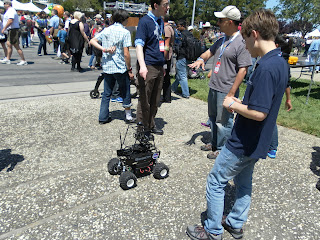Some teams were funded by large corporations like Boeing and Microsoft while others, like the SRM University team from India, had a total budget of $4,000. This included the cost of building the rover and travel for the more than half dozen of its members. While other teams’ rovers had state-of-the-art suspension and power systems, SRM showed up with a batch of radio controlled car batteries and electrical tape.
But overcoming these challenges was the point to the competition. If rovers are going to assist humans in the exploration of Mars, communication system and structural reliability will be critical. That, and probably a healthy dose of electrical tape.
This robot competition happened the week after Judd, Eric, Forest, and Scott finished their closing Mars NorCal engineering crew rotation and prepared our research rover Sandstorm for transport back to the Bay Area.







